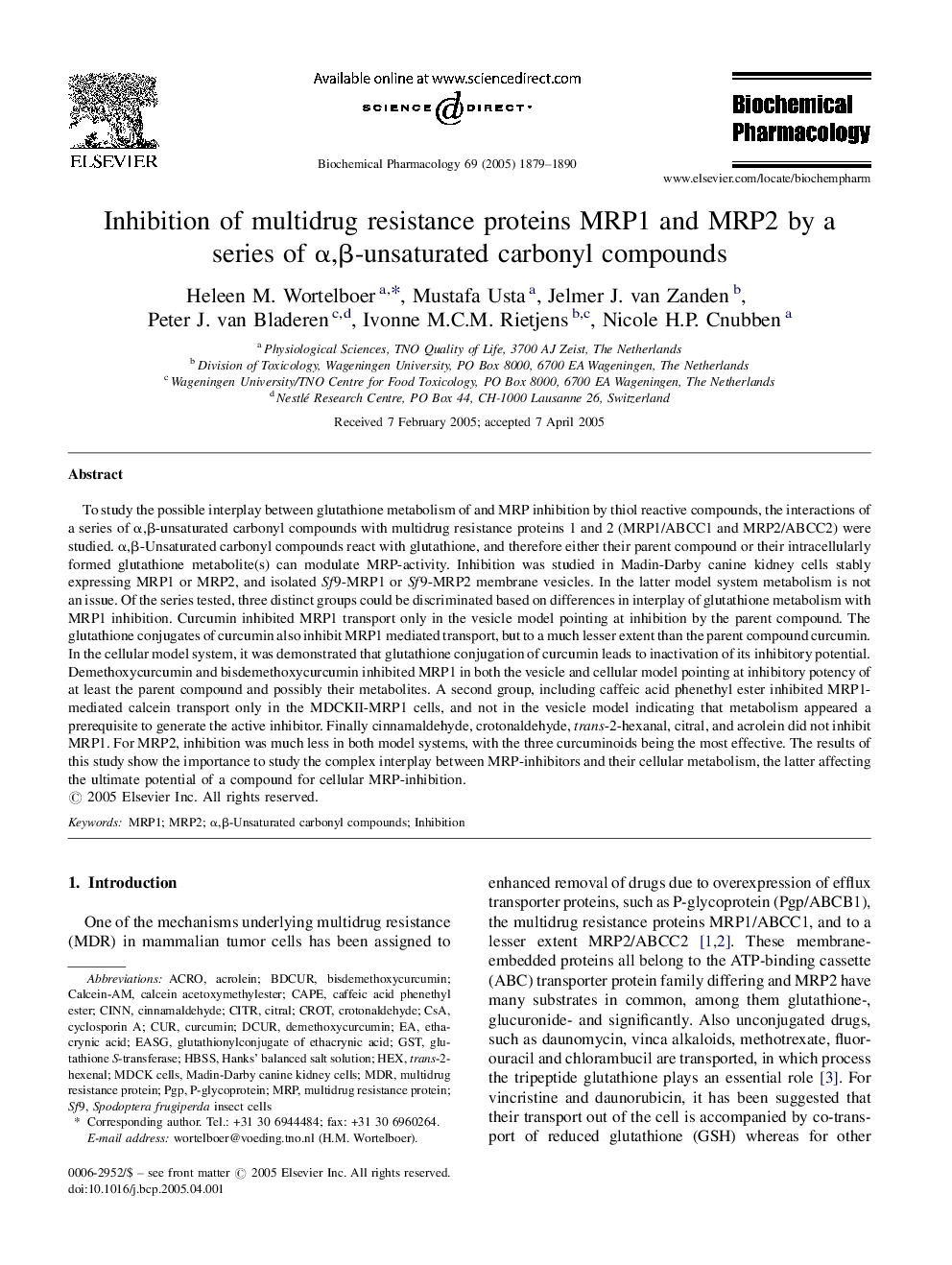| کد مقاله | کد نشریه | سال انتشار | مقاله انگلیسی | نسخه تمام متن |
|---|---|---|---|---|
| 9002042 | 1118569 | 2005 | 12 صفحه PDF | دانلود رایگان |
عنوان انگلیسی مقاله ISI
Inhibition of multidrug resistance proteins MRP1 and MRP2 by a series of α,β-unsaturated carbonyl compounds
دانلود مقاله + سفارش ترجمه
دانلود مقاله ISI انگلیسی
رایگان برای ایرانیان
کلمات کلیدی
CURcalcein acetoxymethylesterCINNCITRCalcein-AMCrotonaldehydebisdemethoxycurcuminDemethoxycurcuminCAPEAcrolein - آکرولئین، آکرولینEthacrynic acid - اسید اتاکریونیکcaffeic acid phenethyl ester - اسید کافئیک اسید فین الی استرCSA - ایالات مؤتلفهٔ آمریکاCitral - سیترالCinnamaldehyde - سینامالدهید cyclosporin A - سیکلوسپورین ACROT - کرتCurcumin - کورکومین
موضوعات مرتبط
علوم پزشکی و سلامت
داروسازی، سم شناسی و علوم دارویی
داروشناسی
پیش نمایش صفحه اول مقاله

چکیده انگلیسی
To study the possible interplay between glutathione metabolism of and MRP inhibition by thiol reactive compounds, the interactions of a series of α,β-unsaturated carbonyl compounds with multidrug resistance proteins 1 and 2 (MRP1/ABCC1 and MRP2/ABCC2) were studied. α,β-Unsaturated carbonyl compounds react with glutathione, and therefore either their parent compound or their intracellularly formed glutathione metabolite(s) can modulate MRP-activity. Inhibition was studied in Madin-Darby canine kidney cells stably expressing MRP1 or MRP2, and isolated Sf9-MRP1 or Sf9-MRP2 membrane vesicles. In the latter model system metabolism is not an issue. Of the series tested, three distinct groups could be discriminated based on differences in interplay of glutathione metabolism with MRP1 inhibition. Curcumin inhibited MRP1 transport only in the vesicle model pointing at inhibition by the parent compound. The glutathione conjugates of curcumin also inhibit MRP1 mediated transport, but to a much lesser extent than the parent compound curcumin. In the cellular model system, it was demonstrated that glutathione conjugation of curcumin leads to inactivation of its inhibitory potential. Demethoxycurcumin and bisdemethoxycurcumin inhibited MRP1 in both the vesicle and cellular model pointing at inhibitory potency of at least the parent compound and possibly their metabolites. A second group, including caffeic acid phenethyl ester inhibited MRP1-mediated calcein transport only in the MDCKII-MRP1 cells, and not in the vesicle model indicating that metabolism appeared a prerequisite to generate the active inhibitor. Finally cinnamaldehyde, crotonaldehyde, trans-2-hexanal, citral, and acrolein did not inhibit MRP1. For MRP2, inhibition was much less in both model systems, with the three curcuminoids being the most effective. The results of this study show the importance to study the complex interplay between MRP-inhibitors and their cellular metabolism, the latter affecting the ultimate potential of a compound for cellular MRP-inhibition.
ناشر
Database: Elsevier - ScienceDirect (ساینس دایرکت)
Journal: Biochemical Pharmacology - Volume 69, Issue 12, 15 June 2005, Pages 1879-1890
Journal: Biochemical Pharmacology - Volume 69, Issue 12, 15 June 2005, Pages 1879-1890
نویسندگان
Heleen M. Wortelboer, Mustafa Usta, Jelmer J. van Zanden, Peter J. van Bladeren, Ivonne M.C.M. Rietjens, Nicole H.P. Cnubben,